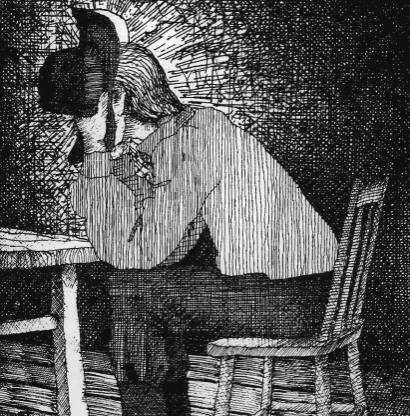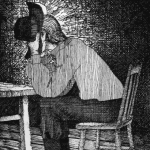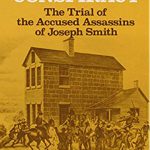Blog
Topic pages: Joseph Smith
July 27, 2021
2019: Steven Shields, “Joseph Smith and Sidney Ridgon: Co-founders of a Movement” Dialogue: A Journal of Mormon Thought, Vol 52 No. 3 (2019): 1–18.
Shields argues that if you deny or dismiss Sidney Ridgon’s contributions to the early church, then the scripture canon during this time would need to be reinterpreted.
2018: Richard Sleegers, “Pedagogy of Perfection: Joseph Smith’s Perfectionism, How it was Taught in the Early LDS Church, and its Contemporary Applicabality,” Dialogue: A Journal of Mormon Thought, Vol 51 No. 4 (2018): 105–143.
Richard Sleegers contrasts 19th century Protestant teachings about salvations to what Joseph Smith taught about life after death.
2016: William Smith, “A Documentary Note on a Letter to Joseph Smith. Romance, Death, and Polygamy: The Life and Times of Susan Hough Conrad and Lorenzo Dow Barnes” Dialogue: A Journal of Mormon Thought, Vol 49 No. 4 (2016): 87–108.
The history behind a letter that was written by missionary Jedediah Morgan Grant to Joseph Smith, which contained infomation about Susan Hough Conrad and her brief love writings with a missionary who was serving in England named Lorenzo Dow Barnes.
2016: Stephen Carter, “Scared Sacred: How the Horrifying Story of Joseph Smith’s Polygamy can help save us” Dialogue: A Journal of Mormon Thought, Vol 49 No. 3 (2016): 75–88.
Carter correlates the story of Abraham and Isaac with the story of Joseph Smith and polygamy.
2016: Bonnie Shiffler-Olsen, “Eight Visions of the First” Dialogue: A Journal of Mormon Thought, Vol 49 No. 3 (2016): 151–155.
Shiffler-Olsen turns Joseph Smtih’s first-person First Vision accounts into poetry.
2016: Fiona Givens, “‘The Perfect Union of Man and Woman’: Reclamation and Collaboration in Joseph Smith’s Theology Making” Dialogue: A Journal of Mormon Thought, Vol 49 No. 1 (2016): 1–26.
Givens argues that one of the things that Joseph Smith was trying to restore was teachings taught to Adam and Eve, in particular men and women working together. Givens also highlighted the existence of Heavenly Mother.
2012: Jonathan Stapley, “Review: JSPP, Histories, Volume 1: Joseph Smith Histories, 1832-1844“ Dialogue: A Journal of Mormon Thought, Web Only.
Stapley examines the different first-person First Vision accounts from 1832–1844.
2010: Benjamin Park, “Salvation through a Tabernacle: Joseph Smith, Parley P. Pratt, and Early Mormon Theologies of Embodiment” Dialogue: A Journal of Mormon Thought, Vol 43 No. 2 (2010): 1–44.
A discussion of the theology of the body being combined with the spirit for various different reasons.
1994: Edgar C. Snow, Jr., “One Face of the Hero: In Search of the Mythological Joseph Smith” Dialogue: A Journal of Mormon Thought, Vol 27 No. 3 (1994): 233–247.
Snow puts Joseph Smith squarely within Joseph Campbell’s famous work The Hero with a Thousand Faces, which is also known as the heroes journey.
1994: Dan Vogel, “The Locations of Joseph Smith’s Early Treasure Quests” Dialogue: A Journal of Mormon Thought, Vol 27 No. 3 (1994): 197–231.
Vogel uses firsthand accounts of people’s reactions to Joseph Smith’s treasure digging.
1993: Lawrence Foster, “The Psychology of Religious Genius: Joseph Smith and the Origins of New Religious Movements” Dialogue: A Journal of Mormon Thought, Vol 26 No. 4 (1993): 1–22.
Foster dives in deep into the psychology behind Joseph Smith’s decisions while he was still living.
1992: Ronald Romig “The Administrative Role of the Presidency: The Founding Prophet: An Administrative Biography of Joseph Smith, Jr. by Maurice L. Draper ” Dialogue: A Journal of Mormon Thought, Vol 25 No. 3 (1992): 197–198.
RLDS Church Archivist Ronald E Romig expected The Founding Prophet: An Administrative Biography of Joseph Smith, Jr. to be exclusively about Joseph Smith. Instead Maurice L. Draper who was both a member of the RLDS Quroum of the Twelve Apostles and the First Presidency, focused more on different adminstrative situations in the RLDS church.
1986: Alan Taylor “Rediscovering the Context of Joseph Smith’s Treasure Seeking” Dialogue: A Journal of Mormon Thought, Vol 19 No. 4 (1986): 18–28.
Taylor identifies the history behind the Smith Family and treasure seeking. During the 19th century treasure seeking is associated with both greed, but also obtaining spirtual knowledge like in Joseph Smith’s case.
1985: Keith Parry “Joseph Smith and the Clash of Sacred Cultures” Dialogue: A Journal of Mormon Thought, Vol 18 No. 4 (1985): 65–80.
Shortly after the church was organized, one of Joseph Smith’s main priorities during his lifetime was preaching to the Native Americans, who he believed to be the descendants of the Lamanites.
1982: Richard Van Wagoner “Joseph Smith: “The Gift of Seeing” ” Dialogue: A Journal of Mormon Thought, Vol 15 No. 2 (1982): 48–68.
Van Wagoner focuses on the seer stones that Joseph Smith used in the Book of Mormon translation process.
1981: Steven L. Olsen “Joseph Smith and the Structure of Mormon Identity,” Dialogue: A Journal of Mormon Thought, Vol 14 No. 3 (1981): 89–100.
Joseph Smith’s 1838 account of the First Vision has taken priority in structuring Mormon identity, despite the existence of different versions. This article explores why that version is so meaningful to Latter-day Saints, reflecting on the symbolic strucutre of the account.
1978: Richard Poulsen “Fate and the Persecutors of Joseph Smith: Transmutations of an American Myth“ Dialogue: A Journal of Mormon Thought, Vol 11 No. 4 (1978): 63–70.
In the 1950s there was a book published call Fate of the Persecutors of Joseph Smith, which contains stories that have been part of folklore that have been passed down discussing what happened to the people who helped kill Joseph Smith.
1975/1976: Jerry Jensen “Carthage Conspiracy: The Trial of the Accused Assassins of Joseph Smith. By Dallin H. Oaks and Marvin S. Hill“ Dialogue: A Journal of Mormon Thought, Vol 10 No. 1 (1975/1976): 84–86.
Review of Carthage Conspiracy: The Trial of the Accused Assassins of Joseph Smith coauthored by Dallin H. Oaks and Marvin S. Hill regarding the trial of Joseph Smith and his brother’s Hyrum deaths. Jensen argues that this book is a mustread for anyone who is interested in ‘Mormon history, philosophy, and the law.’
1974: Eric J. Olson “The Message of the Joseph Smith Papyri: An Egyptian Endowment by Hugh Nibley“ Dialogue: A Journal of Mormon Thought, Vol 9 No. 4 (1974): 74–75.
Review of An Egyptian Endowment by Hugh Nibley, which discusses the papyri that Joseph Smith allegedly used to help translate the Book of Abraham. Hugh Nibley decided to state his case, but allow readers to form their own conclusions after reading it.
1971: Peter Crawley “A Comment on Joseph Smith’s Account of His First Vision and the 1820 Revival“ Dialogue: A Journal of Mormon Thought, Vol 6 No. 1 (1971): 106–107.
Ever since people first heard of the First Vision, the events surrounding it has been clouded by controversy. Crawley comments with historical references that help to clarify this controversy. He compares the story behind Joseph Smith with the 19th Century Baptist preacher David Marks. Even though they never would have met, they have somewhat similar experiences. For them personally, religious experiences in the surrounding area were publicized enough that they would have heard about them in their own home towns.
1971: Lawrence P. Goldrup and Arnold H. Green, “Joseph Smith, an American Muhammad? An Essay on the Perils of Historical Analogy“ Dialogue: A Journal of Mormon Thought, Vol 6 No. 1 (1971): 46–58.
Since around the time as the martyrdom, Joseph Smith has been compared to Muhammad who was the founder of Islam. Green and Goldrup presents evidence for how Islam and the church are different.
1969: Keith Huntress, “Governor Thomas Ford and the Murderers of Joseph Smith“ Dialogue: A Journal of Mormon Thought, Vol 4 No. 2 (1969): 41–52.
Member and non members have criticized Governor Thomas Ford of Illinois for his inability to save Joseph Smith and his brother Hyrum. Huntress was arguing that Governor Ford had a lot of difficulties that he had to deal with at that time.
1969: Richard Lloyd Anderson, “The Reliability of the Early History of Lucy and Joseph Smith“ Dialogue: A Journal of Mormon Thought, Vol 4 No. 2 (1969): 13–28.
Outside the church works that are critical of Joseph Smith and his family are more common than those that are sympathetic. Anderson argues that even though there is an abundance of works that are critical of Joseph Smith, people keep joining the Church.
1968: Max Parkin, “Mrs Brodie and Joseph Smith: Exploding the Myth about Joseph Smith, the Mormon Prophet by F.L. Stewart“ Dialogue: A Journal of Mormon Thought, Vol 3 No. 3 (1968): 142–145.
In response to Fawn Brodies’s biography of Joseph Smith, F.L. Stewart published a book called Exploding the Myth About Joseph Smith, the Mormon Prophet.
1968: Grant S. Heward and Jerald Tanner, “The Joseph Smith Egyptian Papyri: Translations and Interpretations: The Source of the Book of Abraham Identified“ Dialogue: A Journal of Mormon Thought, Vol 3 No. 2 (1968): 92–97.
A description of the alleged Egyptain papyri used by Joseph Smith to translate the Book of Abraham.
1968: Louis Zucker, “Joseph Smith as a Student of Hebrew“ Dialogue: A Journal of Mormon Thought, Vol 3 No. 2 (1968): 41–55.
Zucker describes the efforts that Joseph Smith went through to study Hebrew. Joseph Smith’s personal behavior was apparently not changed, but in other aspects in later years there is evidence that Joseph Smith was using Hebrew language structure
1966: Karl Keller, “’I Never Knew a Time When I Did Not Know Joseph Smith’: A Son’s Record Of The Life And Testimony Of Sidney Rigdon“ Dialogue: A Journal of Mormon Thought, Vol 1 No. 4 (1966): 14–42.
Sometime after Sidney Ridgon passed away, his son wrote a document detailing his father’s life, which he then gave it to the church. The entire document that Sidney Ridgon’s son wrote is contained in this article.
1966: James Allen, “‘The Significance of Joseph Smith’s “First Vision’ in Mormon Thought“ Dialogue: A Journal of Mormon Thought, Vol 1 No. 3 (1966): 29–46.
In this early article, Allen shows that the First Vision was not well known during Joseph Smith’s lifetime. It became well known after the Prophet’s death, which is when missionaries started to teach about it for the first time.


 Back to all blog articles
Back to all blog articles



